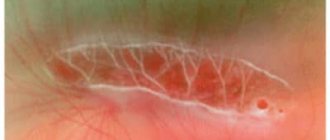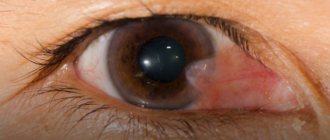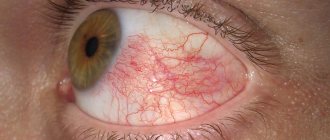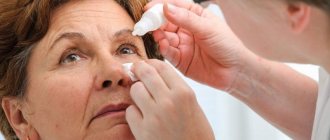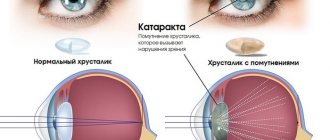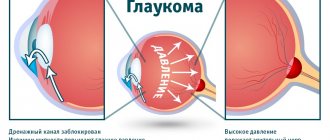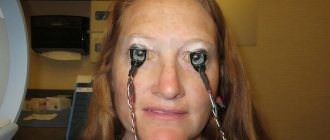Retinal burn - Severe injury to the visual system that occurs when the eye is damaged by chemicals, flames, hazardous liquids, or light energy. It is accompanied by cutting pain, lacrimation, and swelling of the conjunctiva. The eyeball may be affected simultaneously eyelids and skin around the eye, which is also fraught with swelling and the appearance of blisters. But if the skin recovers relatively quickly, a burn to the eye can lead to loss of vision.
A retinal burn is a dangerous injury that can cause vision loss.
First aid
In case of a retinal burn, you need to call an ambulance and provide the patient with all possible first aid.
To do this, the following measures are taken:
- limit the victim’s contact with any types of light, primarily ultraviolet rays;
- if the latter are to blame for the injury, apply a cold compress to the eye;
- dark glasses are put on the wounded person to give his eyes rest;
- if a retinal burn occurs due to alkali getting into the eye, it is washed with a weak solution of acid - citric or acetic (a few drops per half liter of water);
- when the surface of the eye is damaged by acid, use a weak solution of soda.
If the pain in the affected organ is severe and makes you suffer, you can instill a 2% solution of lidocaine or novocaine, and to prevent the development of infections - antibacterial agents, such as chloramphenicol.
Burn symptoms
The primary signs of a retinal burn include pain, pain, and redness of the eyeball and the tissues around it.
Others may appear later:
- drop in visual acuity;
- yellow and red-green spots flashing before the eyes;
- headache;
- swelling of the conjunctiva and eyelids, preventing them from lowering;
- involuntary lacrimation;
- painful photosensitivity;
- sensation of a foreign body in the eye.
The main symptoms of a retinal burn.
When there is a burn to the retina, its symptoms are an alarming indicator. It is necessary to urgently seek medical help.
Retinal burn: causes and treatment
Eye burns are divided into chemical (alkaline, acidic), thermal, radiation and combined (a combination of several damaging agents).
The authorities of the Kirzhach district of the Vladimir region know nothing about the Aquamarine technomusic festival, which, according to some media reports, allegedly took place on the night of July 6 in the forest near the city of Kirzhach and during which about 30 people could have received eye injuries during a laser show.
Burns affect the skin of the eyelids, mucous membrane, lacrimal ducts, cornea, sclera, iris, ciliary body, lens, and retina.
retinal burn - This is perhaps the most severe type of damage to the visual system, as it is difficult to treat, and sometimes it leads to complete loss of vision. Eyes are one of the most vulnerable human organs.
They are not protected from damaging environmental factors, and therefore about 40% of the world's population suffer from eye injury. 29% are children who play with flammable substances or are injured for one reason or another.
One of the causes of vision loss may be a corneal burn.
The retina of the eye is damaged only when the burn is deep. In such cases, there is a sharp deterioration in vision. It is for this reason that it is necessary to urgently seek help from a specialist. Today, much attention is paid to this problem, because a large number of children become disabled due to vision loss.
Degree of eye damage
- Grade 1 - only the superficial part of the eye is damaged.
- 2nd degree - slight darkening and redness of the cornea of the eye occurs.
- Grade 3 - severe clouding of the cornea of the eye is observed. The eye is covered with a thick film.
- Grade 4 - severe damage to the cornea and retina.
Rating: 87
Contents: [hide]
Where and how can you get a retinal burn?
Often, a retinal burn occurs due to exposure to sparks from welding, laser beams, intense sunlight, as well as acids and alkalis. In addition, damage is possible from the juice of poisonous plants, alcohol-containing substances, pepper spray from protective sprays and much more.
It is possible to get such burns both when performing professional duties at an enterprise, research institute and other places of work, and at home, incl. as a result of careless handling of various substances.
Prevention
In practice, it is almost impossible to protect the retina from burns. Such injuries are most often associated with professional activities, so it is recommended to comply with all safety standards and rules in the workplace. When working with chemicals, it is recommended to wear safety glasses or a mask. To carry out welding work, you must wear a special mask. Special dark glasses will help protect your eyesight from sun and water glare.
An excellent preventive measure is visiting an ophthalmologist, performing special exercises, and taking multivitamin complexes. These actions will not protect against retinal burns, but will help strengthen and maintain visual function at the proper level.
Determining the degree of retinal burn
The depth of damage to the retina is divided into degrees.
Light (1st) is characterized by:
- hyperemia of the conjunctiva and eyelid;
- slight retinal erosion.
After some time they disappear completely.
Signs of moderate injury (2nd):
- damage to the surface layer of the skin of the eyelids;
- swelling and shallow necrosis of the retina;
- injury to the cornea, causing it to become dull gray and uneven.
Symptoms of a moderate eye burn.
Full recovery after treatment is possible.
In severe (3rd) necrosis, the cornea, conjunctiva and other tissues are affected: retina, eyelids, cartilage. A matte gray-white scab is formed, after which the body heals the resulting defects. And although in this case no more than half of the eyeball is affected, the complete restoration of the organ is questionable and depends on the measures taken. Cataracts may develop.
A particularly severe degree is characterized by charring and necrosis of the retina, underlying tissues and optic nerve.
The body of the eye in this case resembles a white porcelain ball. For the 4th degree, cataracts, glaucoma and other unpleasant consequences are typical. There is a 1 in 1000 chance of restoration of vision from such damage.
It is difficult to determine the extent of retinal damage immediately after exposure to adverse factors. diagnosis difficult is that for some time the injury may not make itself felt until quantitative changes turn into qualitative ones.
Treatment of eye burns
Treatment of eye burns is carried out in a hospital setting. Therapy is aimed at relieving inflammation and accelerating tissue regeneration. Surgical treatments are usually used for third and fourth degree burns. During the operation, dead areas are removed. Typically, with fourth-degree burns, patients experience complete or almost complete loss of vision, so comprehensive treatment is prescribed to preserve at least residual vision.
Loss of vision with first and second degree burns is most often not observed. For third degree burns, a corneal graft (transplantation) may be necessary.
Classification and types of burns
Retinal lesions can be chemical, radiation, thermal or combined. The latter type includes a welding burn, when the retina is burned by both ultraviolet radiation and flying sparks. Sometimes, if the injuries are not too severe, the eye and vision are restored, but in severe cases, complete regeneration is unlikely.
Main types of eye burns.
Chemical burns
These include burns with acid, alkali, ammonia and ethyl alcohol, quicklime and other substances.
This leads to the following consequences:
- When exposed to alkalis, retinal necrosis occurs with cell death and tissue destruction. The dying area subsequently becomes larger than the area in contact with the alkali, so for the first 2-3 days it is difficult to determine the size of the lesion.
- The results of an acid burn are denaturation of proteins and the appearance of a scab at the site of the injury. In the future, inflammation and side effects associated with secondary infections are possible.
- When lime gets into the eyes, profuse tearing occurs, which helps wash away the solution that gets there. But if the limestone particles are large enough, they can cause a spasm of the eyelids, which makes them more difficult to remove.
The sooner a chemical burn victim is treated , the greater his chances of saving his eye and vision.
Thermal burns
They occur when the eye is exposed to high temperatures. Thermal burns caused by hot steam, boiling water, flames, sparks, and hot fat lead to consequences reminiscent of an acid burn. Changes begin already at a temperature of 45°C, and at 80°C deep damage to the lens and iris occurs.
Light burns
Eye damage caused by strong light is common. This can happen if you look at welding without protection or in bright sunlight. “Snow” burns are also common, when snow in an open space emits blinding rays under the sun.
Such injuries are most often mild to moderate and cause tissue swelling with subsequent degenerative changes.
Chemical burns
Alkalies such as caustic potassium or sodium, ammonia and others are the most common causes of chemical eye burns. The damaging effect of alkalis is a very long process and can last several days. In the first 2-3 days of alkali burns, the symptoms are not serious, so one can misleadingly assume a mild degree of damage. However, such burns cause destruction of the cylindrical body and the tissue of the iris of the eye. In severe cases, destruction of the retina and choroid occurs, as well as damage to the vitreous body and lens of the eye.
The consequences of alkaline eye burns can be atrophy of the eyeball, secondary glaucoma, and the formation of a cataract.
The use of lime in agriculture, construction work and everyday life is often associated with an increased risk of eye burns. When lime solutions get into the eyes, profuse lacrimation occurs, which helps wash them out, which reduces the risk of deep lesions of the conjunctiva. But when large particles of lime get into the eyes, they quickly penetrate the tissues and cause a spasm of the eyelids, which prevents the removal of foreign masses. The sooner medical assistance is provided and the effect of the damaging substance is reduced, the easier the rehabilitation period will be.
Burns resulting from damage to the eyes by acids - hydrochloric, nitric, acetic, sulfuric or others - provoke the formation of deep necrosis of the cornea and conjunctiva. Severe cases of acid burns resulting from tissue necrosis may expose the vascular tract, i.e. middle layer of the eyeball. Regeneration of the eye occurs with scarring and new formation of blood vessels.
Treatment and prevention
To prescribe the correct course of treatment for any type of burn, the doctor conducts a diagnostic examination, which consists of:
- biomicroscopy to assess the volume of the lesion;
- fundus examination;
- assessment of intraocular pressure;
- checking visual acuity using ophthalmological tables;
- perimetry to assess its boundaries.
Diagnosis of eye burns includes a variety of techniques.
If you receive a severe burn to the retina , treatment is carried out in a hospital and involves immediate relief of inflammation and acceleration of regeneration.
It is as follows:
- removing foreign objects if necessary;
- constantly washing the affected organ with water or sodium chloride;
- applying sterile bandages soaked in ointments to the eyes;
- prophylactic injection against tetanus.
In addition, the victim is prescribed the following medications:
- medications to dilate the pupil, used for inflammation and vascular damage;
- metabolic gels and drops that restore metabolism in tissues and promote their healing;
- anti-inflammatory drugs;
- medications that regenerate vision, improve the functioning of the lacrimal glands and protect the eye from external influences;
- antibiotics that fight the inflammatory process and prevent the occurrence of secondary infections;
- medications that reduce dry mucous membranes.
For first-degree burns, with the permission of the attending physician, you can use home remedies:
- honey compresses to prevent corneal clouding;
- lotions with linden decoction to relieve inflammation;
- compresses from raw grated potatoes;
- lotions soaked in aloe juice;
- decoctions of calendula, chamomile and lungwort, which should be taken orally.
Folk remedies for the treatment of retinal burns.
Surgical intervention is carried out in severe and especially severe cases to remove dead areas. In the future, the patient is prescribed complex treatment to preserve residual vision.
To prevent burn damage to the retina, you must:
- strictly follow safety precautions when working with welding machines, aggressive chemical substances, and open flames;
- protect your eyes from the sun and other radiation by wearing tinted glasses ;
- spray household chemicals, incl. perfume, at a distance of at least 30 cm from the face.
According to doctors, if safety measures are followed, it is possible to prevent 90% of accidents associated with retinal .
Retinal burn: first aid and main symptoms
First aid measures for eye burns from the sun are as follows:
- Limit contact with ultraviolet rays and harsh light, turn off bright lamps, close curtains.
- To give the affected organ a rest, you need to wear protective glasses.
- A cold compress for sunburned eyes will help relieve swelling, pain, and watery eyes.
- To prevent soft tissues from drying out, to prevent peeling and complications, use compresses made from strong green tea and lotions with sea buckthorn oil.
- With such injuries, instillation of artificial tears helps.
- If you experience a sunburn on your eyes, you should absolutely not rub your eyelids or touch the burned area with dirty fingers. This will cause a deterioration in the condition, the development of inflammation, and infection.
Subsequent treatment should be prescribed by a specialist after a full examination, depending on the individual characteristics and how the sunburn of the eyes develops.
What are the consequences
In each case they are individual. They can be either temporary or lifelong loss of vision, or complete blindness.
Severe damage can lead to:
- disruption of the lacrimal glands;
- clouding of the cornea;
- constant dry eyes;
- fusion of the eyelid with the mucous membrane;
- slow-onset chronic inflammation;
- detachment of the retina from the choroid;
- cicatricial changes in the eyelids.
Consequences of burn damage to the retina.
Glaucoma and cataract cataracts are also tragic consequences of injury, as is the complete death of the eyeball.
Surgery for eye burns
For severe and especially severe burns, when not only the retina is damaged, but also the rest of the eye, surgery is often required.
During surgery, the damaged parts are transplanted, taking into account the condition of the eye.
There are the following operations:
- Keratotomy, which changes the cornea using incisions on it, performed with a high-precision laser. These measures, in not too difficult cases, allow you to restore vision.
- Penetrating keratoplasty involves replacing the damaged cornea with a donor one.
- Washing the anterior ocular chamber with eye puncture.
- Plastic surgery of the areas around the eyes and eyelids.
- Removal of the eyeball and installation of a prosthesis.
In case of particularly severe injuries, Denig's operation is performed, when the conjunctiva that has undergone necrosis is removed, and the sclera is covered with a thin graft from the mucous membrane of the victim's lower lip.
Contact lenses for burns
Not long ago, scientists created special contact lenses to provide first aid to victims of retinal burns. Their use eliminates many complications in the future. The lenses contain a special composition that neutralizes hazardous substances that end up in the eye when a burn occurs. They are simple and easy to use and act as a sterile dressing that protects the affected area. When using these lenses, eye recovery occurs much faster.
Treatment
In the case of a chemical burn, many ocular tissues are affected. In this case, you will need to rinse the eye with plenty of water at room temperature or saline. To wash off a dangerous substance, you need to rinse your eyes for at least a quarter of an hour. Under no circumstances should you hesitate, and after washing, be sure to take the victim to the hospital.
It is important to know that if an eye burn occurs with alkali, it is strictly forbidden to rinse the eyes with water. The alkali and water react, which will only make the situation worse. In this case, the eyes should be washed with a diluted solution of acetic or boric acid.
If the injury occurred in chemical production with the toxic chemical aniline, then it is imperative to rinse the eyes with a highly diluted solution of ascorbic acid. When treating the retina of the eye for a retinal burn, it is effective to apply a bandage to the organ of vision, previously soaked in cool water or medicines.
After completing all the necessary manipulations, the eyes must be instilled with antimicrobial drops. In the room, turn off the lights and close the curtains.
If the injury affected not only this area, then there is no need to rinse the eyes. It is enough to apply a cold compress to closed eyelids and give an analgesic. It is imperative to take the victim to the clinic so that the ophthalmologist can prescribe therapy.
Conservative therapy
Treatment consists of:
- anesthesia of the conjunctival membrane with local analgesic drugs;
- washing the eyes with saline solution to remove all dangerous substances;
- instillation of antibiotics to prevent infection of the burn wound;
- instillation of medications that restore injured tissue, as well as improve blood circulation;
- use of anti-inflammatory drugs;
- replacement treatment with medications analogues of tear fluid.
If the patient's intraocular pressure increases, then antihypertensive treatment is indicated.
Why laser devices and pointers are dangerous for eyesight
They are inexpensive, used in work, study, and for lighting fires.
A laser pointer can cause retinal burns.
But their radiation, even the lowest power, is dangerous to the eyes and can cause burns and hemorrhage into the vitreous body, since prolonged exposure to the laser beam damages blood vessels. It is recommended to use only certified and relatively safe devices, because the beam of a laser pointer that is not suitable for everyday use can hit the eye at a great distance and harm its health.
This happens for the following reasons:
- Bright light sharply and painfully contracts the muscles of the pupil, as a result of which a veil of black dots appears before the eyes, which are fragments of damaged tissue floating in the vitreous body. Vision drops sharply, objects begin to blur and look unclear.
- Exposure to the beam leads to tearing, redness of the eye due to rupture of blood vessels, pain and headache.
- Prolonged exposure to the laser can cause retinal burns.
Loss of vision occurs due to hemorrhage, so after the incident, you must first immediately apply a cold compress, causing the vessels to contract and not bleed, and only after that seek medical help.
Why do burns appear after laser and how to remove them?
Not so long ago we saw these devices only in science fiction films, but today they are available in almost all modern medical centers and even in ordinary beauty salons. And, as with any other serious method of influence, their safety comes to the fore.
Burns to the skin of the face or body, as well as the retina and mucous membrane of the eye are one of the most common complications after laser procedures. In order to minimize the risk of their occurrence, not only the professionalism of the cosmetologist is important, but also what equipment he works with. In addition, the individual characteristics of the patient are important, in particular the Fitzpatrick skin color type.
What do you need to remember to avoid unpleasant consequences? Is it true that there are lasers that do not cause burns? What to do if the skin does burn? We have collected all the most important information on TecRussia.ru:
↑ How do cosmetic lasers work and how safe are they?
The operation of any devices used for aesthetic procedures is based on controlled thermal damage. A light pulse, focused into a thin, targeted beam, penetrates the skin to a predetermined depth and heats the target area. Depending on the task facing the cosmetologist, in this way it is possible to either partially damage (to start the regeneration process) or completely destroy (to remove tumors, scars, tattoos or unwanted hair) the desired type of cells:
| Laser type | Scope | What is it used for? |
| Ruby, wavelength 694 nm | Energy is absorbed primarily by melanin contained in skin cells, hair, birthmarks and age spots, as well as blue and black dyes used for tattooing. | Tattoo removal, hair removal, work with hyperpigmentation |
| Alexandrite, wavelength 755 nm | Mainly affects melanin, as well as blue, black and green tattoo ink pigments. | Removal of tattoos, age spots and melasma. |
| Diode, wavelength 808 mn | Absorbed by melanin and hemoglobin of red blood cells. | Removal of vascular networks, treatment of vein diseases, laser skin rejuvenation. |
| Neodymium, wavelength 1064 mn | Absorbed predominantly by oxyhemoglobin - a pigment contained in blood cells, as well as hemoglobin. | Laser surgery, treatment of varicose veins, removal of unwanted hair, acne, skin photorejuvenation procedures. |
| Erbium (wavelength 2940 nm) and CO2 laser; | The pulse energy is absorbed by water molecules contained in tissues | Tissue cutting during surgical operations, removal of benign neoplasms (xanthelasma, warts, mucous cysts, lycoplakia, etc.), skin peeling. |
Thus, the laser in any case causes a small, controlled burn, which is what it works for. The problem is that local heating can spread to surrounding tissues, and at a fairly large distance from the target area. It is almost impossible to completely avoid this effect, especially in the case of such aggressive procedures as resurfacing, however, the parameters of the equipment can be adjusted in such a way as to achieve the desired aesthetic result without causing serious damage to the skin.
↑ Why are burns possible after laser?
Typically, heat injuries occur due to one or more of the following factors:
- the cosmetologist ignoring or concealing important contraindications to the procedure by the patient;
- the absence of a cooling system in the device used or its insufficient efficiency;
- incorrect choice of laser type, incorrect radiation intensity setting;
- incorrect technique for carrying out the laser procedure (loose contact of the handpiece with the skin, application of pulses, etc.);
- the use of excessively intense radiation in areas with delicate skin (perianal area, labia minora);
- careless work with tanned and dark skin of IV-VI color types according to Fitzpatrick.
↑ ...And how to avoid them?
Patient safety during laser procedures largely depends on the professionalism of the cosmetologist. Therefore, the main recommendation here is to take a responsible approach to choosing a specialist and find a doctor who you can trust with your skin without fear. But there are a few more points that are important to remember:
- The risk of burns increases significantly for patients who sunbathed in a solarium or in the open sun shortly before the procedure, as well as for those who are undergoing a course of tetracycline antibiotics or sulfonamides - if you deliberately or forgetfully do not inform the cosmetologist about this, the consequences can be the most unpleasant.
- Be sure to ensure that the device you use has a good cooling system. This could be, for example, a directed flow of cold air, or the presence of a special window in the handle with circulating water at a temperature of 2-4 degrees. Adequate cooling helps prevent heat from spreading to the tissue surrounding the target area (hair follicle, tumor being removed, tattoo area containing pigment, etc.)
- The radiation intensity and type of laser are selected by a specialist, taking into account the number of procedures already performed on the patient, skin type, presence of a fresh tan, hair thickness and color during hair removal, etc. At the same time, the first session is usually carried out on fairly “soft” settings of the device - if no problems arise, then in the future the power of the light flux can be increased.
| Photo 1,2 – severe damage to the face and a burn on the neck after laser hair removal: | |
- If there are moles on the target area of skin, before starting the laser procedure (be it hair removal, peeling or any other effect), they must be covered with a special light-proof plaster. Some specialists, in order not to waste time, simply close each of the neoplasms with a spatula. However, the result can be just the opposite: a laser beam reflected from the mirror surface of a metal tool often causes skin burns under its edges. It’s even worse if you don’t pay any attention to moles at all: their pigment-filled cells actively absorb heat, as a result, even after a single session, the new growth can burn so much that it becomes charred on top. Such trauma, in turn, can lead to malignancy of the mole and its degeneration into melanoma. To avoid such risks, it is necessary to seal the tumors before each session or remove them once according to all the rules.
- Laser hair removal on thick black hair often results in burns for the simple reason that a large amount of pigment absorbs and releases more energy. This means that after the first procedure, even if performed perfectly, intense redness and rawness of the skin may appear. All subsequent sessions are usually much easier to bear.
↑ What does Fitzpatrick have to do with it?
The skin's reaction to the effects of a cosmetic laser is largely determined by its color type, or, simply put, by the amount of melanin pigment in the cells. To determine it, there is the Fitzpatrick scale:
| Color type | Characteristic | Features of laser procedures |
| I – Celtic | Milky white skin, very thin and delicate, often with freckles. Almost does not tan and quickly burns in the sun. Blonde or red hair. Green or blue eyes. | – |
| II – Nordic or Aryan | Light skin with virtually no freckles. Hair is light, brown or brown. The eyes are light. The tan doesn't apply well. | – |
| III – dark European | The skin is light or slightly dark, without freckles. Eyes gray or brown. Hair is dark brown or brown. The tan goes on easily. | – |
| IV – Mediterranean | Dark skin, which is also often called “olive”. Dark eyes and hair. The tan goes on quickly and evenly. | It is preferable to carry out procedures using a neodymium laser. It is necessary to take a very serious approach to choosing a professional who will carry out the procedure. |
| V – Indonesian | Very dark skin. Dark eyes and hair. They never get sunburned. | Similar to type IV |
| VI – African-American | Very dark skin. Black hair and eyes. They never get sunburned. | For people with this color type, laser procedures are usually contraindicated: the risk of burns and the development of hyperpigmentation is too high. |
The general idea is that the lighter the skin, the less it absorbs light energy, and the lower the likelihood of burns. Dark-skinned patients are recommended to undergo procedures only using a neodymium laser, the radiation of which does not have such an active effect on pigmented cells.
If you have a fresh tan, regardless of color type, you should not expose your skin to additional damaging influences. It would be better and safer to postpone the sessions for 1-2 months. This will allow you to get more predictable results and avoid unnecessary complications.
↑ A few words about retinal burns
Our eyes are extremely sensitive to any intense light. Even a regular laser pointer aimed at the retina causes temporary blindness in just a few seconds. What can we say about powerful devices used in cosmetology: they can cause irreversible damage and deprive the patient of vision almost instantly. Naturally, we are talking about those cases when the beam is directed directly into the eye, which, in theory, should not happen. However, this is not a reason to neglect safety precautions and refuse to use special protective glasses, which are mandatory for patients before starting the procedure. And that's why:
- In the laser therapy room there are likely to be shiny surfaces from which the beam can be reflected and end up in the eyes.
- In addition, scattered flashes that come at some distance from the handpiece are not particularly useful. The lens of the eye serves as a lens that further focuses the beam onto the retina, which without proper protection also leads to burns.
Recognizing laser eye injury is not difficult. The main symptoms are a sharp decrease or complete loss of vision, headache, lacrimation, the appearance of “floaters” (which is nothing more than a large number of particles of damaged tissue that float in the vitreous). Unlike skin burns, which can usually be treated at home within a few days, if you suspect retinal damage, you should seek immediate medical attention. The sooner this happens, the higher the likelihood that vision will be restored without complex operations on the eyeball.
- Cosmetology laser Palomar (Palomar)
- Mixto laser is better than Fraxel!
↑ How to treat burns after laser
As we have already said, minor thermal damage to the skin is unlikely to be avoided. Therefore, you should stock up in advance and then regularly smear the injured area with external agents that accelerate tissue restoration. Most often, for this purpose, cosmetologists recommend:
- Panthenol and Dexpanthenol;
- Solcoseryl.
These drugs are available in any pharmacy and are relatively inexpensive. As a last resort, any remedy for sunburn and other burns will do.
| Photo 3 – blisters on the burned area of the chest after laser lipolysis and the consequences of face resurfacing: | |
In cases where the skin is more significantly damaged (the main signs are blisters and/or open wounds), you should not rely only on yourself. Especially if the burns are located on the face and other open areas of the body. It is necessary to report the incident to the clinic where the procedure was performed as quickly as possible. This is necessary not only to receive medical care, but also to ensure that the incident is investigated - in particular, to look for possible equipment malfunctions that could cause other patients to suffer.
If there is no trust in the clinic for any reason, you should then seek advice from a third-party specialist dermatologist, dermatocosmetologist or aesthetician cosmetologist and carry out subsequent treatment under their guidance. Typically, it includes:
- Treatment of the injured area: relieving inflammation (the same Panthenol and similar products) and disinfection (open wounds, if any, are washed with hydrogen peroxide).
- Application and further regular change of a bandage soaked in a healing agent (most often Levomekol is used) until the skin is completely regenerated.
- If necessary, painkillers are prescribed for the first days.
- If the patient has a tendency to form keloids, it is possible to use anti-scarring drugs (Contractubex, Dermatix, etc.) - but not before the edges of the burn wound have fused. In other cases, it will be enough to protect the healing area from mechanical influences (even rubbing with a towel after a bath is extremely undesirable) and ultraviolet radiation.
| Photo 5,6 – healing of a burn on the abdomen after laser hair removal (took about 3 months): | |
As delayed consequences of temperature damage to the skin, the following are possible:
- hyperpigmentation of the injured area, especially in cases where a person spends a lot of time in the open sun or visits a solarium against doctor’s recommendations;
- scar formation;
- infection with the formation of a weeping wound.
Each of these cases requires separate therapy and multifaceted care for the injured area, as well as medical supervision.
↑ But are there completely safe lasers?
In advertising materials of cosmetology clinics, you can periodically find statements that “our device does not cause burns.” There can be three most likely explanations here:
- A service or equipment model new to the Russian market is used. For example, recently IPL systems have been actively promoted in our country. Many domestic doctors who attended seminars to learn how to use the new product are confident that it is better, more efficient and safer than laser devices of previous generations. However, foreign specialists who already have quite a lot of experience working with IPL do not share the enthusiasm of their Russian colleagues. Any, even the most advanced technology, has its own characteristics and side effects, which sometimes become obvious only after numerous “trials and errors”.
- An extremely careful approach to setting up the device. To avoid possible conflicts due to burns, some clinics require their specialists to use only laser settings that are guaranteed not to lead to skin damage. This is, indeed, completely safe, however, and the result of the impact will ultimately be, if not zero, then very weak.
- The procedures are performed by a top-class specialist. The option is the best, but, unfortunately, also the rarest of all listed. Today, to obtain permission to work with laser equipment, a cosmetologist only needs to take short-term courses. Naturally, it is impossible to comprehend all the nuances and subtleties in just a few, even very intensive classes, which means that mistakes are inevitable at first. If the laser machine is really in the hands of a professional with sufficient experience, then the promise of a guaranteed result in several procedures without burns and other complications can be trusted.
↑ Experts' opinions:
| Ivanova Irina Nikolaevna cosmetologist-dermatologist, doctor of the highest category, DoctorPlastic clinic: Various types of lasers are used in cosmetology. There are ablative procedures in which we specifically cause burns, ablation (evaporation of tissue). This, for example, is fractional resurfacing - a traumatic, but very effective procedure in the fight against aging, scars, incl. post-acne, stretch marks. And there are non-ablative procedures, in which temperature damage to the epidermis should not occur. This is, for example, laser hair removal or laser coagulation of blood vessels. However, even in this case, sometimes burns still occur if:
Therefore, the cosmetologist must know about all the medications you take, when you were on vacation (or in a solarium), etc. During procedures, an aqueous conductive gel is often used, and the working surface of the laser terminal is very cool. This helps prevent burns. Also, there is the so-called “cold hair removal”, in which the hair does not receive all the energy at once, in one impulse, but gains it gradually. This is easier for the patient to tolerate and is the safest in terms of burns. When it comes to laser rejuvenation or removal of blood vessels, the rules remain the same. And remember, the lighter your skin, the more effective and safe the procedure will be! If unwanted burns do occur, you should immediately notify your doctor! Most often, it is enough to simply lubricate the injured area with Bepanten, Ozonide oil or another product. Under no circumstances should you open the blisters (if any) or peel off the crusts, otherwise a scar may remain. Therefore, it is better that all treatment also takes place under the supervision of your doctor. And to protect yourself as much as possible, you should remember a few simple rules:
|
| Vishipanova Nadezhda Leonidovna cosmetologist at the Frau Clinic, Ph.D.: The main risk factors are tanned or damaged skin and incorrectly selected exposure parameters. Burns are most likely during laser hair removal, removal of blood vessels and pigmentation. Therefore, these procedures require appropriate preventive measures: firstly, they are not carried out on a fresh tan, and secondly, the intensity of the effect must be individually selected based on the skin phototype, treatment area, diameter and depth of the vessel, pigment, thickness and hair color . Similar problems occur much less frequently with fractional photothermolysis. |
| Gogiberidze Nino Malkhazovna Dermatovenerologist, cosmetologist, Clinic K+31: Both laser hair removal and resurfacing damage the skin, making it more sensitive and susceptible to the external environment. With an incorrectly set intensity of exposure and incorrect post-procedure care, burns, hyperpigmentation, and poor healing are possible. Allergic reactions and exacerbation of herpes may also occur. A qualified doctor will be able to correctly assess the phototype and select the correct parameters for the procedure. Also, before the session, the specialist will definitely carry out the necessary treatment of the skin, and upon completion, will apply an anti-inflammatory and healing agent. Patients need to know that treating such burns at home is contraindicated. If any problems arise, you should immediately contact your doctor, who will prescribe the necessary therapy - antibacterial, healing, anti-inflammatory. Patients with tanned or dark skin are at high risk of complications during laser procedures. Also, such effects are not recommended for people with acute inflammatory diseases, increased photosensitivity and a tendency to allergic reactions. |
